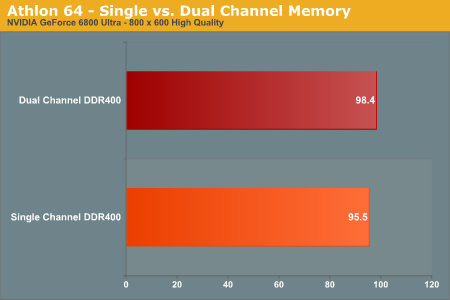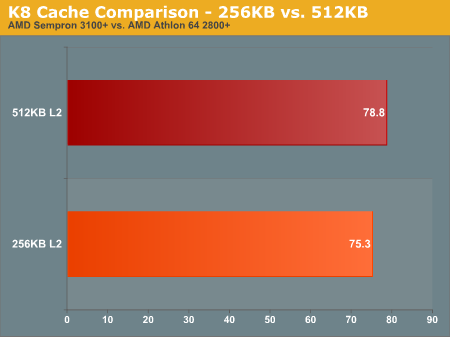Battle 2: AMD vs. AMD
Next up on the fight list for today is AMD, competing against themselves. AMD has gained quite a bit of popularity over the past year and needless to say it is because of their extremely strong showing with the Athlon 64. That being said, with three different flavors of Athlon 64s (Socket-754, Socket-939 and FX) and a lot of users still hanging onto their Athlon XPs, AMD's performance breakdown is an important one to look at.
We know by now that Doom 3 is very cache intensive, which in turns means its very memory intensive - bringing us to our first evaluation: Athlon 64 vs. Athlon 64 FX. The Athlon 64 FX once held two advantages over the Athlon 64, a larger 1MB L2 cache and dual channel memory controller. Now with the introduction of Socket-939, the Athlon 64 also has dual channel capabilities but only on newer chips, not the older Socket-754 offerings. As you can guess, there are two comparisons we'd like to make here: Dual Channel vs Single Channel as well as the impact of cache size on performance.
First we'll tackle dual vs single channel memory interfaces; for this test we used a Socket-939 Athlon 64 FX-51 (2.2GHz/1MB L2) as our Dual Channel platform, and a Socket-754 Athlon 64 3400+ (2.2GHz/1MB L2) as our Single Channel platform. You can see that other than the sockets, the two chips are identical, making this the perfect single vs dual channel memory comparison:

Memory bandwidth doesn't seem to be something that the regular Athlon 64 needs much more of, as the move to dual channel DDR400 only offered a 3% increase in performance. At higher resolutions, the performance advantage would become even smaller. We didn't really expect anything different here, as the dual channel memory interface never really helped the Athlon 64 - definitely not as much as it did the Pentium 4.
Next, let's see how cache size influences Athlon 64 performance under Doom 3. For this comparison we have four chips to compare in two separate sets. We use an Athlon 64 2800+ and a Sempron 3100+, both clocked at 1.8GHz but feature a 512KB and a 256KB L2 cache respectively. We also have an Athlon 64 FX-53 and an Athlon 64 3800+, both clocked at 2.4GHz but feature 1MB and 512KB respective cache sizes. While the four numbers are not directly comparable to one another, the two comparisons do give us an idea of improvements due to cache size varying from 256KB up to 1MB on the Athlon 64:

Looking at the Athlon 64 vs Sempron we see that there's barely a 5% performance difference between the two identically clocked chips, indicating that although a 256KB L2 cache isn't big enough for Doom 3 a 512KB L2 cache doesn't help out that much more. The on-die memory controller helps ensure that despite the small cache size, performance remains very competitive with the competition as we will soon see in our fourth battle.

Our 512KB vs. 1MB L2 cache size comparison reveals something interesting: it's not that a 512KB L2 cache isn't big enough for Doom 3 (which is the case with the Pentium 4), it's that the Athlon 64's on-die memory controller effectively masks the need for a large L2 cache in Doom 3. Going to a 1MB L2 cache results in less than a 4% performance improvement, much less than what we saw with Prescott vs. Northwood.
Bottom line: cache size is far less important for the Athlon 64 than on the Pentium 4 as you would expect thanks to the on-die memory controller.










59 Comments
View All Comments
Anemone - Thursday, August 5, 2004 - link
I suggest you look at the low and average framerates for the EE @ 1600x1200. From memory I recall on HardOCP was that the AMD chips had a higher top end and a lower low end, making the average, whereas the P4's had high and low ends not so far away from their average.AMD64's fly, but at higher res's 1280 up to 1600, the difference is a few fps, and P4's seem to not fly as fast, but also not bottom out as bad in the super heavy scenes.
While I'm torn on the issue of which platform to go to, that is something I noticed.
DigitalDivine - Thursday, August 5, 2004 - link
Shinei, hardocp did not use apples to apples comparisons.dmxlite - Thursday, August 5, 2004 - link
"When tested at 1600 and real gameplay, Athlon 64 falls like a brick, as shown in the "Official Doom 3 hardware guide" at HardOCP."Yes, that must be the reason why in the conclusion they say "AMD came out ahead in DOOM 3 performance with the strongest CPU in our tests, the Athlon 64 FX-53 processor," and why they chose the stock FX to be in their [H]ard|OCP Ultimate DOOM 3 System and an overclocked A64 3000+ to be in their [H]ard|OCP Ultimate Enthusiast DOOM 3 System.
nlr_2000 - Wednesday, August 4, 2004 - link
It's called an on die memory controller ;)Staples - Wednesday, August 4, 2004 - link
Interesting how P4s were always top dog in Q3 but now with D3, it is the opposite.Shinei - Wednesday, August 4, 2004 - link
I don't know about you, T8000, but I can't complain about my (underclocked) 64MB Ti4200 and 3200+ XP combination. It drags in some areas (9fps as a low, 60 as a high, average gameplay flow is around 20; settings are 10x7 medium quality), but it's definitely playable in singleplayer, with very little mouse lag.So, for my Athlon XP to be performing fairly well with 2-year-old, underclocked hardware, I'm willing to say that HOCP is probably making things retarded for AMD by changing settings or something. I find it very hard to believe that the vastly superior Athlon 64s (compared to my Athlon XP) would falter so heavily in gameplay when my own processor does not.
T8000 - Wednesday, August 4, 2004 - link
I think you cannot say a CPU is better because it produces more frames in situations where it is hardly stressed, like lower resolutions and timedemos. Furthermore, I think most people want to play at an acceptable framerate with as much detail as possible, so testing a GF6800U only at 1280 and without playing the game, is not realistic.When tested at 1600 and real gameplay, Athlon 64 falls like a brick, as shown in the "Official Doom 3 hardware guide" at HardOCP. Only the overclocked Athlon FX could do slightly more then the P4EE at stock settings.
flexy - Wednesday, August 4, 2004 - link
>>>Whether the top-performing FX53 is worth the $811 price is up to you,
>>>
The answer is of course: NO
Neither is the PIV EE worth its price :)
flexy - Wednesday, August 4, 2004 - link
the most important info for me is that it's actually nonsense to wait for socket 939...or useless to spend more money for 1mb cache.So...socket 754 is even better/faster and cheaper. And the 512kb cache are plenty too for the A64.
This is very helpful info in regards to upgrading my system soon :)
Pumpkinierre - Wednesday, August 4, 2004 - link
Nice article Anand- strange set of results. I'd like to see the benchmark for a 2.4c at 3200MHz with same memory latency settings. If it is memory latency as the a64 results suggest then the Prescott should be lower or even beaten by N'wood. If it is L1 cache size then the EE result should be lower.